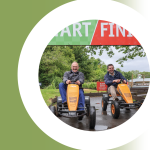
Dr Caroline Leicht
Visiting Fellow, Department of Politics and International Relations, University of Southampton
Her research focuses on gender, media and politics, with a focus on gender and representation in new media and non-traditional news media.
E-Mail: c.v.leicht@gmail.com
Twitter: @carolineleicht

UK Election 2024
Section 8: Personality politics and popular culture
87. Ed Davey: Towards a Liberal Populism? (Dr Tom Sharkey, Dr Sophie Quirk)
88. Why Nigel Farage’s anti-media election interference claims are so dangerous (Dr Lone Sorensen)
89. Nigel Farage and the political circus (Dr Neil Ewen)
90. Binface, Beany and Beyond: humorous candidates in the 2024 General Election (Prof Scott Wright)
91. What Corbyn support reveals about how Starmer’s Labour won big (Prof Cornel Sandvoss, Dr Benjamin Litherland, Dr Joseph Andrew Smith)
92. “Well that was dignified, wasn’t it?”: floor apportionment and interaction in the televised debates (Dr Sylvia Shaw)
93. TV debates: beyond winners and losers (Prof Stephen Coleman)
94. Is our television debate coverage finally starting to match up to multi-party politics? (Dr Louise Thompson)
95. Tetchiness meets disenchantment: capturing the contrasting political energies of the campaign (Prof Beth Johnson, Prof Katy Parry)
96. “We’re just normal men”: football and the performance of authentic leadership (Dr Ellen Watts)
97. ‘Make the friendship bracelets’: gendered imagery in candidates’ self-presentations on the campaign trail (Dr Caroline Leicht)
98. Weeping in Wetherspoons: generative Al and the right/left image battle on X (Simon Popple)
99. An entertaining election? Popular culture as politics (Prof John Street)
100. Changing key, but keeping time: the music of Election 2024 (Dr Adam Behr)
101. Truth or dare: the political veracity game (Prof John Corner)
If anyone had fun on the campaign trail, it was Ed Davey – that appeared to be the consensus among social media users during the campaign. Davey’s Instagram account features images of him trying thrill rides, gleefully riding a bike with both legs in the air, or falling off a paddleboard. When asked what inspired him to share such unconventional campaign posts, Davey said it was his way of showing that politicians are just normal people too.
But there is more to it. Images hold significant power on the campaign trail, and they can invoke specific emotions and gendered perceptions of political leadership among voters. While Davey focused on thrill rides and other activities, Rishi Sunak and Keir Starmer relied on more traditional campaign imagery, but with stark differences. Here, I will consider the gendered self-presentations of the candidates, using the example of Instagram posts by Sunak and Starmer.
When we speak about gendered representations, we more often than not mean stereotypical associations with gender and social roles. Despite growing representation of women in political leadership roles, executive roles are still seen in highly masculinized terms. For instance, the view of an ideal president or prime minister is often associated with stereotypically masculine characteristics such as agency or strength. But this is not always what voters look for in a candidate. Particularly during crises related to stereotypically feminine policy themes such as health and social welfare, voters are more likely to support candidates who display stereotypically feminine traits such as empathy and who emphasize community.
The UK has undoubtedly seen political turbulence in recent years and is facing significant challenges related to healthcare, education and social welfare, including the cost of living crisis. From that perspective, a good campaign strategy this year should have been to use more stereotypically feminine visuals in campaign communications, for instance showing community engagement and empathic listening, and invoking relatability.
In line with this strategy, Rishi Sunak’s Instagram posts showed him engaging with the public and represented more stereotypically feminine visuals during the early days of the campaign. For instance, Sunak was shown crouching down to interact with children, feeding lambs on a farm, taking selfies and embracing voters, high-fiving a junior women’s football team, and posing with his own children for Father’s Day.
Two weeks before Election Day, however, Sunak’s Instagram strategy shifted. He increasingly posted images that represented more stereotypically masculine visuals: Sunak standing tall among a sea of voters, giving energetic speeches, driving a tractor, cheering on England in the UEFA Euros with a fist in the air. He was less frequently shown engaging with community leaders and other voters as had been the case in the earlier weeks of the campaign. Indeed, Sunak often centred himself in his Instagram posts, putting the focus on him as the agentic political leader. Even posts about the less political elements of the campaign did not quite hit the mark on presenting a down-to-earth, one-with-the-people image: Sunak was pictured getting takeaway twice but missed the opportunity to be pictured interacting with the workers while doing so.
Keir Starmer, on the other hand, presented himself through more stereotypically feminine visuals throughout the campaign. He was less likely to be front and centre in his posts but was instead usually pictured with others, whether it be Labour candidates across the country, voters, or community leaders. His Instagram account is a record of Starmer engaging with the community at eye-level, embracing voters, laughing with them, and attentively listening. Such posts portray Starmer as an empathetic leader who cares about citizens’ concerns and well-being, invoking stereotypically feminine associations with an ideal political leader during times of social welfare crises.
Starmer did not present the ‘normal people’ image quite like Ed Davey did, yet he had his own interpretation of the strategy, tailored to a primarily female and younger audience. In June, he attended Taylor Swift’s The Eras Tour with his wife and subsequently built on associated imagery, for instance posting an image of a ‘Vote Labour’ friendship bracelet, perhaps hoping to further engage this key demographic of young women voters. While the connection between Swift and the friendship bracelet may not be clear for those who are not fans of the singer (fans began trading friendship bracelets at The Eras Tour based on a line in Swift’s song ‘You’re on Your Own, Kid’), a friendship bracelet also invokes other memories and emotions related to community, further strengthening Starmer’s image of an empathetic, community-focused political leader.
There are many factors that played a role in this election, but gendered perceptions of political leadership remain relevant for voting behaviour. While campaign images such as those shared by Ed Davey may simply provide comic relief during a serious political time, campaign imagery offers substantial opportunities for candidates to reach specific voter groups and present themselves as the ideal candidate through subtle, visual cues. Whereas Sunak missed several opportunities to do so, Starmer’s posts on social media suggested a keen awareness and understanding of this key campaign strategy.
